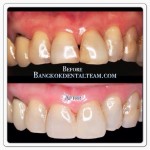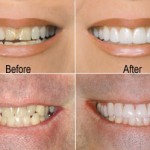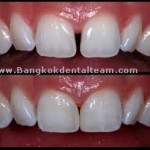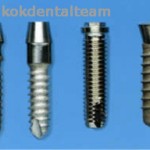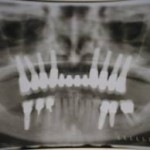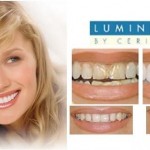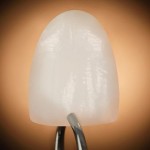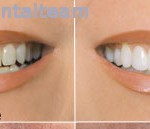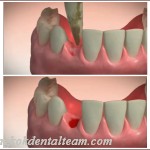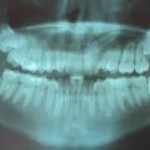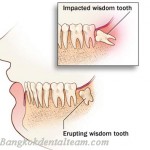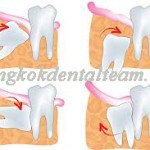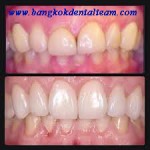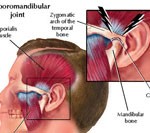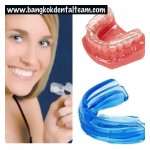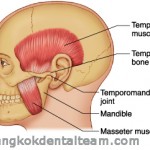-
Teeth Bleaching (Teeth Whitening)
-
Dental Laminated Veneer
Veneers are done to cover teeth discoloration.
Q : What is “Veneer”?
A : A “Veneer” is an artificial enamel showing in the front and is made of plastic or ceramic in order to substitute a real surface of a natural tooth which might be loss or has an unwanted discoloration.
Q : How many types of Veneers are there? And what are they?
A : There are 2 major types of “Dental Veneers” classified by the process of making a veneer.
Direct Veneer : made directly inside the mouth
Indirect Veneer : made in the laboratory and delivered to the mouth.
If classified by material used for making a veneer, there are 2 types of material used:-
Resin Composite
Ceramic or Porcelain
Q : Which type is best?
A : Veneers are made for the same purpose, no matter what they are made from. Since Ceramic or Porcelain are more esthetic, natural-like, and stronger than resin, a choice of Ceramic or Porcelain Veneers are selected when esthetic and strength are major concerns. However, they are pricier than that of resin and consume more dental visits due to the fact that there are laboratory procedures. On the contrary, resin type can be done directly inside the mouth and can be finished in one setting. Therefore, if you have limited time and budget, while getting an acceptable esthetic, then a choice of resin type can be selected.
There is, however, another type of resin veneer that is made from the laboratory which will give more esthetic and strength, but still cannot compare to that of a ceramic type.
Q : When is the time for Veneers?
A : Veneers are usually made on the front teeth area or on all visible areas – especially when smiling or speaking. When having tooth surface loss, filling up the area may not yield esthetic result or not so strong, or in case of tooth discoloration and teeth whitening cannot efficiently work, Veneers can be used in these cases.
picture1 Veneers are done to cover teeth discoloration.
Besides, Dental Veneers can be made when teeth are not in good alignment, such as, spacing or crowding. Veneer shape can be designed to cover the spacing or the crooked area. However, veneer should be done for minor correction of teeth mal-alignment only, not severe case which can be corrected by some other means, such as, orthodontics, false teeth, etc.
picture 2 High canine has been extracted and cover the spaced area with a veneer to have a harmonized look without having to undergo orthodontic treatment.
picture 3 Spaced teeth can be covered using Dental Veneers resulting in a better smile.
-
Dental Implants
Q : What is a Dental Implant?
A: Different types of screw implants
An implant is an artificial root made from a biocompatible material that is implanted to replace lost teeth. Standard implants today are screw or cylinder form made from titanium.
Titanium is a unique metal: It can be incorporated in the bone without an intermediate layer. This intimate contact between bone and titanium is called osseointegration. Another advantage of titanium is it does not cause allergic reactions, rejection, nor inflammation of the oral mucosa. Because of its biocompatible qualities, titanium is broadly used for other medical implants, for example hips, knees, etc.
Normally, dental implants have a length of 6-15 mm and a diameter of 3-5 mm. On the market there are numerous companies producing implants, but only few systems are supported by scientific studies and long-term results
Q : How is an Implant Placed?
A: Careful planning is the first step preceding an implant operation. With help from x-rays and study models, the amount of bone is measured in length and width, so the ideal position for a suitable implant can be planned.
A : Implantation is a surgical intervention performed under sterile conditions that can take between 45-90 minutes. Implantation can be done without pain using local anesthesia. Nevertheless, the procedure can be stressful for some patients. For this reason, we offer treatment to be done under conscious sedation, using nitrous oxide (laughing gas) or other sedatives. The advantage is complete relaxation and comfort for the patient.
For larger operations, like bone augmentation, or for dental phobic patients, we can also offer general anesthesia. An expert team of anesthesiologists can accompany us within the Clinic St. Anna, or in our private practice.
After the gum tissue is numb, it is carefully opened. With a sequence of calibrated burs, the implant bed is prepared. To prevent overheating of the bone, preparation is done with sterile water cooling. The suitable implant is chosen and placed. The gum tissue is sutured over the implant and a temporary prosthesis or bridge is seated.
-
Orthodontic Treatment (Braces)
Q : Is it necessary to have teeth pulled in every orthodontic case?
A : Generally, orthodontics needs to have movements of teeth. In case of very little space for such movements, for example, crowded teeth, then it is necessary to gain space for teeth to be able to move. This can be done by either having some of the teeth pulled out or reducing the size of some teeth. If there is enough space, for example, some teeth had been pulled out, have missing teeth, or generally spacing, then it may not be necessary to pull out more teeth.
Q : What about wisdom teeth? Do they need to be removed before braces?
Or can be done afterward?
A :
“Wisdom teeth” have never been wanted by any dentists; therefore, even if not having orthodontic treatment, they are strongly recommended to be removed. This is to help make the cleaning inside the oral cavity easier and more thoroughly. However, the necessity of wisdom teeth removal depends on many factors; for example, age, teeth and gum condition, etc., which the dentist will evaluate individually.
Oral care in those who have orthodontic appliances in the mouth is more complicate than in those who do not have. If there is any wisdom teeth that are hard to take care of, the teeth are usually advised to be taken out. This is not just for orthodontic purpose, but also for a better oral hygiene. If found that the wisdom teeth may come up in a direction which can push other teeth out of the alignment, then to remove the wisdom teeth prior to or during orthodontic treatment is recommended. If not, then after orthodontic treatment is done, the well-aligned teeth may move to undesired position causing problems of rotated or crooked once again and the patient needs to come back to redo the braces all over again to straighten the teeth. This time, the orthodontic process maybe more complicated than the first time. Wearing retainers is still necessary as retainers can help keeping the teeth into their aligned position although the wisdom teeth have not yet been removed. The problem of crowding is likely not easy to occur. Nevertheless, to remove the wisdom teeth is still recommended – especially, when the wisdom teeth have erupting direction that can push other teeth to move out of alignment.
-
Get yourself ready for braces
-
Lumineers
Lumineers
LUMINEERS™ are porcelain veneers that offer the painless way to a permanently whiter and perfectly aligned smile. Your LUMINEERS™ dentist can apply these contact lens-thin “smile shapers” to teeth without any grinding or shaving, transforming teeth into a naturally beautiful smile that looks perfect for every individual. LUMINEERS can even be placed over existing crown or bridgework without having to replace them.
LUMINEERS™ are contact lens-thin and are placed over existing teeth without having to remove painful tooth structure* (unlike traditional veneers.) LUMINEERS™ is the painless, permanent cosmetic solution for stained, chipped, discolored, misaligned teeth or spaced teeth and are proven to last, in an on-going study, for up to 20 years!** (results available upon request). Use Cerinate Porcelain LUMINEERS™ to change your smiles and lives.
LUMINEERS™ has developed the contact lens thin porcelain technology that preserving your natural tooth structure. And that means you can correct a wide variety of unsightly dental distortions or conditions, such as:
– Tooth discoloration
– Noticeable gaps
– Permanent stains
– Broken or misshapen teeth
– LUMINEERS can even bond to existing crowns and bridgework without having to replace them
Before
Teeth are stained, slightly misshapen with spaces in-between. An impression is made and the m old is sent to the Cerinate Smile Design Studios where
After
-
Oral and Maxillofacial Surgery
Oral Surgery
What is Oral Surgery?
Oral and maxillofacial surgery is the specialty of dental practice that deals with the diagnosis and surgical treatment of diseases, injuries and defects of the mouth, jaws, face and related structures. This includes the removal of impacted and decayed teeth, placement of dental implants, biopsy and removal of cysts and tumors of the mouth and jaws, treatment of facial trauma and reconstructive jaw surgery.
TOOTH EXTRACTION/REMOVAL
Non – Surgical Extraction
This method will be suggested when the affected tooth is already loose. Non-surgical extraction is performed by placing gentle traction and rotation on the affected tooth with dental forceps or needle holders. Excess tissue is removed as carefully as possible so as to avoid fracture. Once clean, the alveolus can be filled with osteoinductive materials, impregnated resins, or the newer bone morphogenic materials. After filling, the alveolus is sealed. Following the procedure we will try and make you as comfortable as possible by providing home care support including antibiotic therapy, pain management, and dietary advice.
Surgical Extraction
Surgical extraction is performed on non-mobile teeth with normal or near normal attachment levels. If your dentist has studied your radiographs and concluded that extraction is necessary the next step will be the creation of a surgical flap. Your highly skilled oral surgeon will make a precise incision providing room to remove the alveolar bone. Following this the surgeon will isolate and gently elevate the roots of your tooth. After sufficient bone removal and elevation, the tooth root should become mobile. Small dental forceps or needle holders are used to grasp the tooth crown and then rotate the tooth on its long axis. Your surgeon will rotate the tooth to the point of resistance for 20 to 30 seconds. The rotation is then reversed and again held for 20 to 30 seconds. By using slow, continuous forces, the fibers are torn and the tooth becomes loose enough for gentle traction to remove it from its socket.
After the roots have been successfully removed, a post-extraction radiograph will confirm that the operation has been successful. The alveolus can then be treated and sealed in the same way as practiced in the non-surgical extraction.
Wisdom teeth
Wisdom teeth serve no useful function and will often cause damage because when a wisdom tooth becomes partially exposed through the gums it cannot be cleaned properly and can collect food debris, bacteria and plaque around itself. This can result in tooth decay, gum disease, infection and abscess of not only the wisdom teeth, but of the nearby molars and surrounding gum tissue. The molars in front of the wisdom teeth are sometimes lost because of cavities and gum disease caused by the inability to clean the wisdom teeth properly. Cyst formation and other destructive pathology are also seen around impacted wisdom teeth. There may be pain and swelling, or you may have no symptoms at all, even though the other teeth in your mouth may be at risk of damage.
If removal of the wisdom teeth is necessary, the procedure is recommended in the late teenage years, before the roots are completely formed. Surgical procedures in general are better tolerated when one is young and healthy, and the gum tissues tend to heal better and more predictably when young. Most people experience minimal disruption of their normal routines, and time off from work or school is usually minimal. At this point it is worth noting that the removal of wisdom teeth can be of great benefit to your ultimate oral and general health.
Wisdom Teeth Problems
Whether wisdom teeth cause your mouth harm depends on several factors, including the size of your jaw and how your wisdom teeth grow in. Sometimes, problem wisdom teeth cause symptoms like pain and swelling. Or you may have no symptoms at all but the other teeth in your mouth could be at risk for damage.
These are the most common complications of leaving impacted wisdom tooth in place:
1. Decay, or dental caries. The positioning of wisdom teeth makes them hard to clean and hard to repair.
2. Fluid filled cysts. These can form from remnants of tissue around the crown of the tooth, becoming large and painful.
3. Infection of the surrounding gum tissue. This condition, pericoronitis, is most likely to occur if the tooth is partly erupted or very close to the surface.
Instruction for After Dental Extraction
Post Operative Care For Dental Surgery.
1.After tooth extraction or oral surgery,bite on this gauze for one or two hours.
2. Do not Spit or put ice chips on the incision.
3. Rinse your mouth with warm salt or soda water, and Brush your teeth very gently for the first two days.
4. If the pain increases 2 days after surgery,Please contact your dentist.
5. Consume a liquid or soft diet but use straws.Avoid hot and spicy food and don’t smoke.
6.Stitches may be removed within 5-7 days
-
Root Planing
Root Planing
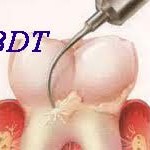
Root planing involves smoothing the root surfaces of your teeth with thin curettes so gum tissue can more firmly reattach to roots that are clean and smooth to prevent tooth loss and sensitivity problems. The procedure makes it more difficult for plaque to accumulate along the root surfaces. Because this procedure goes deeper than a regular cleaning, your mouth may be numbed. The cleaning may take two visits to complete. Depending on the extent of the disease you may need one or more sections (quadrants) of the mouth to be treated with scaling and root planing. Treatment may require one or more visits.
-
Gum Surgery
Crown Lengthening
Crown Lengthening and Cosmetic Treatment
Crown lengthening is used to correct what’s commonly referred to as a “gummy smile” that hides the beautiful teeth underneath the gums. A gummy smile is apparent when the gum line appears to be creeping down over the teeth, making them appear short. During this procedure, excess gum and bone tissue is reshaped to expose more of the natural tooth and more beautiful smile. This can be done to one tooth, to even your gum line, or to several teeth to expose a natural, broad smile.
Crown lengthening is a simple surgical procedure which adjusts the position of the gum around the affected tooth.
-
Occlusion & Temporomandibular Disorders (TMD)
Occlusion and Temporomandibular Disorders
Your tooth and gum are very important, so do your muscles of
mastication, and jaw joints. Sometimes, some people grind their
teeth at night time. This can result in tooth wear, pain in muscles
of mastication and jaw joints. If you are one of those who suffer
from this problem, please do not hesitate to meet our specialist
Dental Occlusion or Malocclusion is an extremely common dental condition caused when the biting surfaces of the teeth do not properly fit together. The way teeth grow out of the jaw is influenced by a number of factors, as heredity, shape of the jaw, and certain environmental conditions can lead to uneven variations in biting surface. If left untreated these variations in jaw structure can eventually cause problems with biting, gum health, speech development, and the ability to maintain proper oral hygiene.
Most dental occlusion are treated after adult teeth begin to grow in, as the bones and teeth are far more pliable than those of adults. In some cases the dentist will have to remove one or more permanent teeth to ensure proper growth and expansion of other teeth. Great care is exercised to prevent future impaction or irritation by other teeth that have yet to erupt, so many people who have malocclusion are required to wear a retaining device or mouthpiece to prevent complications.
Bruxism
Bruxism is the technical term for grinding and clenching that abrades teeth and may cause facial pain. People who grind and clench, called bruxers, unintentionally bite down too hard at inappropriate times, such as in their sleep.
People who have otherwise healthy teeth and gums can clench so often and so hard that over time their teeth become sensitive. They experience jaw pain, tense muscles and headaches along with excessive wear on their teeth. Forceful biting when not eating may cause the jaw to move out of proper balance.
Temporomandibular disorders (TMD)
Temporomandibular disorders (TMD) occur as a result of problems with the jaw, jaw joint and surrounding facial muscles that control chewing and moving the jaw. These disorders are often incorrectly called TMJ, which stands for temporomandibular joint.
What Is the Temporomandibular Joint (TMJ)?
The temporomandibular joint (TMJ) is the hinge joint that connects the lower jaw (mandible) to the temporal bone of the skull, which is immediately in front of the ear on each side of your head. The joints are flexible, allowing the jaw to move smoothly up and down and side to side and enabling you to talk, chew, and yawn. Muscles attached to and surrounding the jaw joint control the position and movement of the jaw.
What Causes TMD?
The cause of TMD is not clear, but dentists believe that symptoms arise from problems with the muscles of the jaw or with the parts of the joint itself.
Injury to the jaw, temporomandibular joint, or muscles of the head and neck – such as from a heavy blow or whiplash – can cause TMD. Other possible causes include:
– Grinding or clenching the teeth, which puts a lot of pressure on the TMJ
– Dislocation of the soft cushion or disc between the ball and socket
– Presence of osteoarthritis or rheumatoid arthritis in the TMJ
– Stress, which can cause a person to tighten facial and jaw muscles or clench the teeth
Common symptoms of TMD include:
Pain or tenderness in the face, jaw joint area, neck and shoulders, and in or around the ear when you chew, speak, or open your mouth wide
– Limited ability to open the mouth very wide
– Jaws that get “stuck” or “lock” in the open- or closed-mouth position
– Clicking, popping, or grating sounds in the jaw joint when opening or closing the mouth (which may or may not be accompanied by pain) or chewing
– A tired feeling in the face
– Difficulty chewing or a sudden uncomfortable bite – as if the upper and lower teeth are not fitting together properly
– Swelling on the side of the face
– May occur on one or both sides of the face
Other common symptoms of TMD include toothaches, headaches, neck aches, dizziness, earaches, hearing problems, upper shoulder pain, and ringing in the ears (tinnitis).
Pages
- Gallery
- Testimony
- Our Dentists
- Store
- Our Place & Facilities
- Interesting places nearby
- Knowledge
- Technology
- SERVICE
- Services
- Price
- Appointment
- Promotion
- About us
- Map
